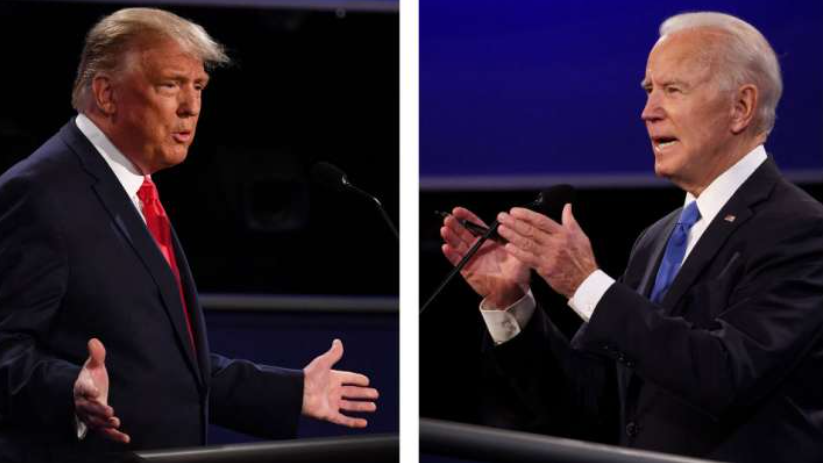As the 2024 election looms on the horizon, President Joe Biden faces a daunting challenge: despite his approval ratings consistently below 50%, he’s counting on the idea that voters will choose him over any Republican alternative, under the mantra of “Don’t measure me against perfection; measure me against the competition.” However, recent polling data casts doubts on this assumption, suggesting that the road to reelection might be more treacherous than anticipated.
Despite facing approval ratings consistently below 50%, President Joe Biden often leans on a straightforward message: “Don’t measure me against perfection; measure me against the competition.”
In essence, he’s suggesting that while he might not be everyone’s favorite, voters will still choose him over any Republican alternative.
Yet, here’s the catch: The polling data suggests that Biden’s assumption may not hold water, and this could spell electoral trouble for him in the upcoming year.

Both President Trump and President Biden are grappling with unfavorable popularity ratings. According to our latest poll, Trump stands at 35% favorability among registered voters, while Biden clocks in at just 36%. Interestingly, those who favor one candidate do so passionately, with over a 90-point lead over the other.
So, here’s the kicker: The upcoming election hinges on the 29% of voters (per our poll) who don’t have a favorable view of either candidate. This group, which includes both undecided voters and those who dislike both candidates (“double haters”), holds the key to the election outcome.
This scenario may sound eerily reminiscent of 2016 when almost 20% of voters disliked both Hillary Clinton and Trump. Trump secured a decisive 17-point lead among this group, securing his victory. (CNN Politics Updates)
Earlier this year, Biden held a narrow lead over Trump among voters with unfavorable views of either candidate. However, in our latest poll, Trump has surged ahead by 7 points among this 29% segment. Notably, 21% of this group indicated they either won’t vote or will opt for another candidate in a Trump-Biden faceoff.
While a 7-point lead falls within the margin of error, recent polls from Quinnipiac University and The New York Times/Siena College have produced similar results, with Trump holding a single-digit advantage and a significant portion of voters expressing reluctance to support either major-party nominee.
If this continues to hold, Biden’s theory of the case for 2024 is in major trouble.

Now, it’s possible the president isn’t too worried, thinking that those who hold favorable views of neither him nor Trump come from segments of the electorate that are, on the whole, voting for Biden and that they could be persuaded to move back into the president’s camp as the election progresses.
Our poll, however, doesn’t show that to be the case. Among this group, 42% are Republicans (or independents who lean Republican), 41% are Democrats (or independents who lean Democratic) and 17% are pure independents.
The margin between Democrats and Republicans basically matches what we see in the electorate overall.
Even if we limit ourselves to those who like neither man and who say they aren’t voting for either one at this point, Democrats are still not overrepresented. In other words, there’s no reason, at this time, to think this block of voters will move toward Biden, unless something changes.
There are about another 14 months until the 2024 election. Things can and often do change within this time frame. That is a rare piece of good news for Biden in a sea of otherwise very worrisome data.
Election 2024 Our analysis of this:
In the lead-up to the 2024 election, President Joe Biden’s strategy of urging voters to measure him against the competition, rather than perfection, may face substantial challenges. Despite consistently low approval ratings below 50%, Biden has counted on the belief that voters will ultimately prefer him over any Republican alternative. However, recent polling data suggests that this assumption might not hold water.
With both President Biden and former President Trump sporting favorability ratings in the mid-30s, the election’s outcome is likely to pivot on the 29% of voters who neither view Biden nor Trump favorably. This group encompasses both undecided voters and “double haters” – those who dislike both candidates. This scenario evokes memories of the 2016 election when Trump secured victory by a significant margin among voters who disliked both him and Hillary Clinton.
While earlier in the year, Biden held a narrow lead among voters with unfavorable views of either candidate, recent polls indicate that Trump has surged ahead by 7 points in this crucial 29% segment. Alarmingly, a substantial 21% within this group express their intent to abstain from voting or choose an alternative candidate in a Trump-Biden matchup.
These trends pose a significant challenge to Biden’s reelection prospects, challenging his theory of winning over these voters as the election unfolds. Our polling data reveals that this group is evenly divided between Democrats, Republicans, and pure independents, reflecting the broader partisan split in the electorate. At this point, there is little reason to believe these voters will gravitate toward Biden, unless there are substantial changes in the political landscape.
We are closely follow the step of election USnewsSphere.com, With approximately 14 months remaining until the 2024 election, there is room for shifts and surprises. This potential for change offers a glimmer of hope for President Biden amidst an otherwise concerning backdrop of data. The road to reelection remains uncertain, and the outcome will largely depend on how these pivotal voters ultimately decide to cast their ballots.





